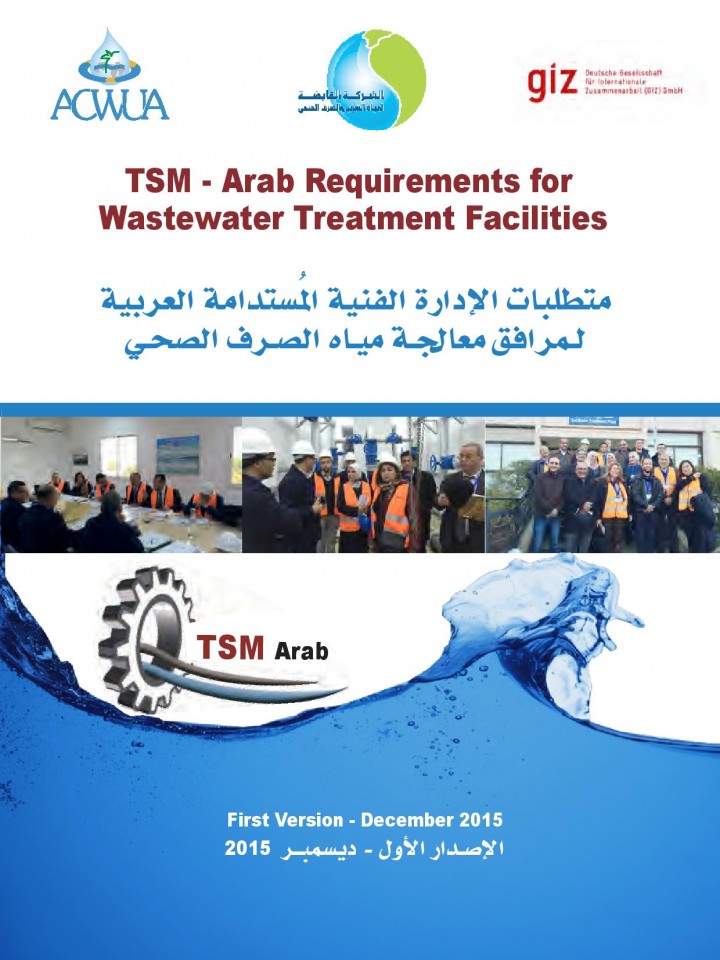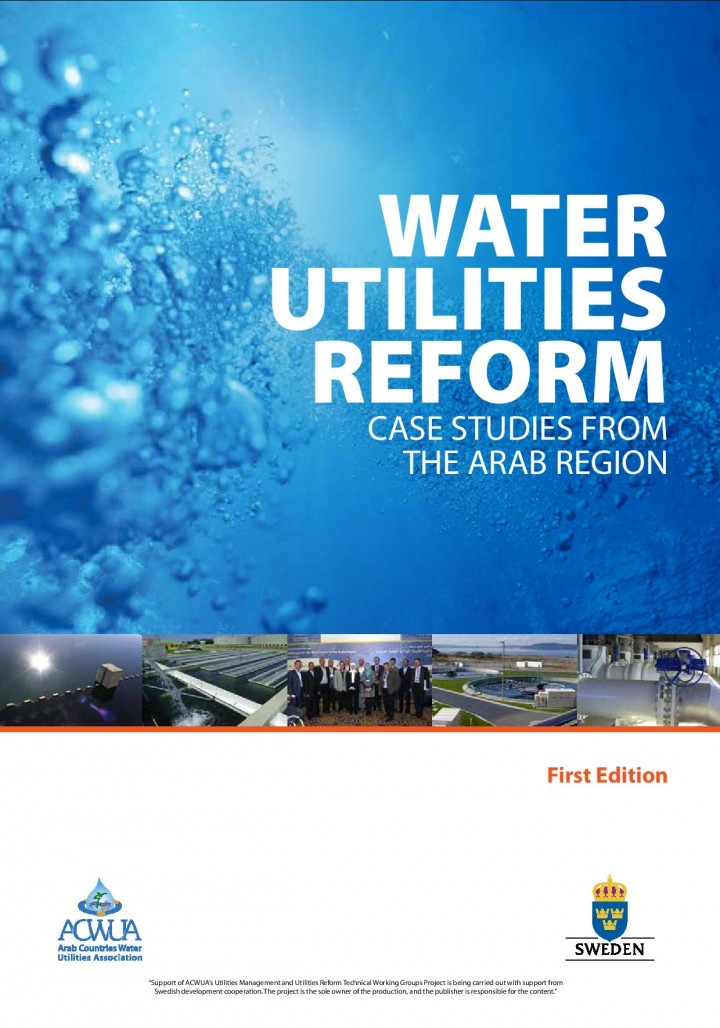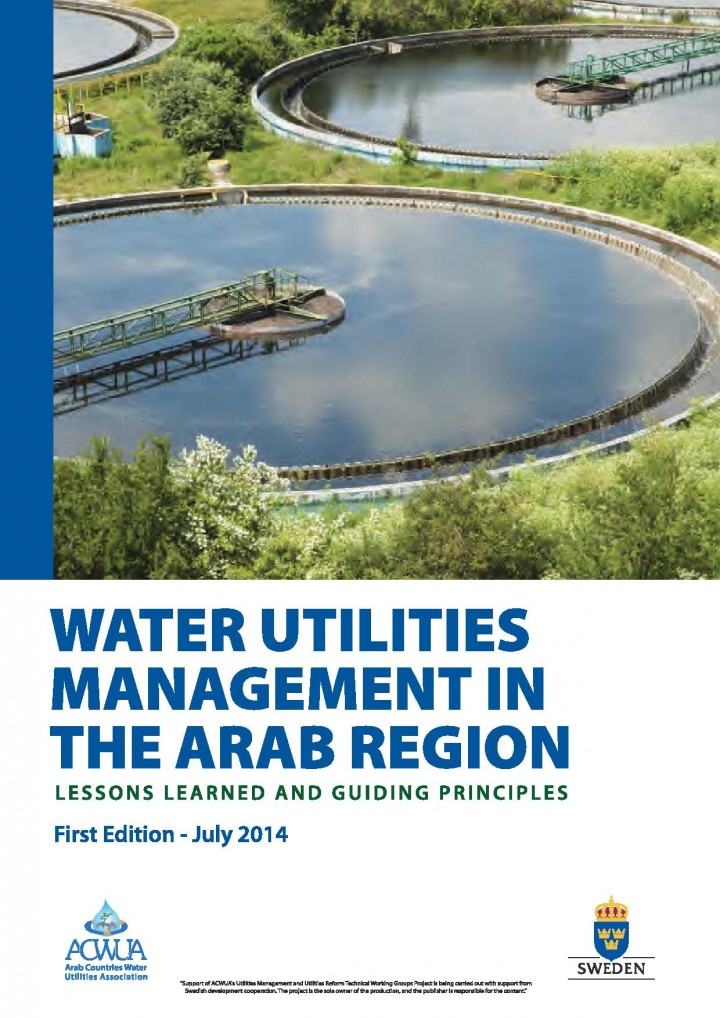Ray, I., Prasad, CS S. (2018) Where there are no Sewers Photoessays on Sanitation Work in Urban India
November 19 is World Toilet Day. Enormous progress has been made in the global effort to provide safe and affordable toilets for the world’s poorest citizens since World Toilet Day was first declared in 2001. Significant strides have been made in “reinventing” toilet designs for low-income, water-short, unsewered urban zones; celebrites such as Bill Gates and Matt Damon have brought this once-taboo topic into the […]
ACWUA and GIZ (2015) TSM - Arab Requirements for Wastewater Treatment Facilities (in Arabic) متطلبات الادارة الفنية المستدامة العربية لمرافق معالجة مياه الصرف الصحي
Technical Sustainable Management TSM (Arab) is a Quality Management System managed by the following stakeholders: - ACWUA-WANT programme as financing and supervision of the TSM-Arab implementation. - Arab Countries Water Utilities Association (ACWUA) - TSM-Arab Task Force of ACWUA members quality management system) - Holding Company for Water and Wastewater (HCWW) as consultant of the programme - German International Cooperation GIZ. TSM (Arab) requirements aims at the development of Water and […]
ACWUA (2016) Water Utilities Reform Case Studies from the Arab World
The main deliverables of the work of the TWG during the period of its engagement are two reports: 1. A compilation of the UR TWG regional case studies report, which covers the main theme of the TWG for the participating ACWUA member countries; and 2. A best practices guide in the area of utilities reform that is applicable in the region. The publication in hand is the first […]
ACWUA (2014) Water Utilities Management in the Arab Region Lessons Learnt and Guiding Principles
This publication provides an in depth analysis of the regional experience in utilities management such as non-revenue water, cost recovery, and energy efficiency. It further provides success factors, opportunity for replication and improvement.
Feumba, R., Burchard-Levine, A. (2018) SFD Report - Yaoundé, Cameroon (in English and French) SFD Promotion Initiative
Yaoundé is the political capital of Cameroon and had 3,660,082 inhabitants with 775,911 households in 2017 (updated from RGPH, 2010). The area covered for this SFD is 310km², which is beyond the administrative boundaries as the city developed peripherally in an unregulated manner. The population growth rate was nearly 5.3% per year between 2001 and 2015 and 5.7 between 2015 and 2020 (CUY, 2015). Around 3% […]
Talamini, G., Burchard, A. (2018) SFD Report - São Paulo, Brasil (Portuguese and English) SFD Promotion Initiative
O gráfico SFD foi construído para o município de São Paulo, capital do Estado de São Paulo e integrante da Região Metropolitana de São Paulo. É o município mais populoso do país e um dos maiores do mundo. Segundo Instituto Brasileiro de Geografia e Estatística (2018) o município possuía 11.967.825 residentes em 2015. O município possui uma área de 1.521 km², densidade demográfica de 7.398 hab/km², […]
Kajyibwami, J., Burchard-Levine, A. (2018) SFD Report - Ouagadougou, Burkina Faso (in English and French) SFD Promotion Initiative
Ouagadougou is the capital of Burkina Faso and the largest city of the country. It is located in the central region of Burkina Faso and had a population of 2,532,311 in 2015 (INSD, 2015) and projected total population of more than 2.7 million in 2017 (ONEA, 2017). The population density is estimated to be 903 persons per km2 within its municipal council area of 2,805 […]
Heyer, A., Kappauf, L. (2018) SFD Report - Mavoko, Kenya SFD Promotion Initiative
Mavoko Town is one of the eight sub-counties of Machakos County in Kenya, which is located around 30km southeast of Nairobi. The whole area of Mavoko covers 963 km2 including large rural parts. This SFD focuses on the service area of the local Water Service Provider (WSP) named Mavoko Water and Sewerage Company (MAVWASCO). The WSP serves the urban agglomerations of Mavoko, which are organized […]
Talamini, G., Burchard, A. (2018) SFD Report - Manaus, Brasil (Portuguese and English) SFD Promotion Initiative
O Município de Manaus é a capital do estado do Amazonas e está localizado na Região Norte do Brasil. A Região Hidrográfica chama-se Amazônica e ocupa 45% do território nacional. A densidade populacional é 10 vezes menor que a média nacional, entretanto, a região concentra 81% da disponibilidade de águas superficiais do país. Manaus é a maior cidade da Amazônia e a sétima maior cidade […]
Kappauf, L., Heyer, A., Makuwa, T., Titova, Y. (2018) SFD Report - Lusaka, Zambia SFD Promotion Initiative
Lusaka is the capital city of Zambia. Situated in the central part of Zambia on the Central African Plateau it is one of the fastest-developing cities in Southern Africa. Lusaka is both the political and economic centre of Zambia. Lusaka District is located within Lusaka Province, the smallest but most densely populated of the eleven Zambian provinces (CSO, 2014). According to projections by the Central […]
GFA Consulting Group GmbH (2018) SFD Report - Kakuma, Kenya SFD Promotion Initiative
The SFD graphic and report covers Kakuma town and Kakuma refugee camp. Kakuma town is located in northern Kenya, in the northwestern part of Turkana County approximately 123 km north of the county capital Lodwar and about 100 km east from the border to South Sudan. Kakuma town is located on the eastern bank of Tarach River. In 2018, the town population is around 58,878 […]
Feumba, R., Burchard, A., Kappauf, L. (2018) SFD Report - Douala, Cameroon (in English and French) SFD Promotion Initiative
Douala is the economic capital of Cameroon. In 2005, Douala had 1,907,479 inhabitants (RGPH, 2010). With a growth rate of 4.7%, the population of the city was estimated to be 3,309,939 inhabitants in 2017. The total area of the city (excluding Douala VI and Wouri River) is about 41,000ha. According to ENSP/L3E (2014), 30 to 40% of the area is occupied by slums. Only 50% […]
Westhof L., Dang, T. (2018) SFD Report - Da Lat, Vietnam SFD Promotion Initiative
Da Lat is located on the Langbiang highland plateau at the northern area of Lam Dong Province. The city consists of 12 wards and 4 communes with a total population of 226,978 people by the end of 2017 (CIPTT, 2018). The maximum population density in the central region is 15,632 people/km2, and only 100 people/km2 in the communes. Nearly 100% of the population in Da Lat […]
Fischer, P., Westhof, L., Dang, T. (2018) SFD Report - Buon Ma Thuot, Vietnam SFD Promotion Initiative
Buon Ma Thuot is the capital city of Dak Lak province. It is located in the southwest of Dak Lak and borders Dak Nong province in the west and four districts of Dak Lak province in the other directions. It has a population of about 457,000 (Statistic Office of Vietnam, 2016) with a general growth rate of 1.12% per year. In Buon Ma Thuot, 18% of […]
Badruddin, I. (2018) SFD Report - Thatta, Pakistan SFD Promotion Initiative
Thatta is the main city of Thatta district, in the province of Sindh, Pakistan and has a population of 101,833 (Census, 2017) individuals in 17,998 households. Thatta city is spread over an area of 3823 km² (urban/Rural) and has a population density of 109 people per km². There are no pit latrines in Thatta, and there is almost no use of septic tanks. 85% of the […]
Biad, M., Petermann, T., Feuerstein, L., Herman-Friede, J. (2015) WATER TAP Manual A practical guide to managing water integrity in water utilities: Experiences from pilot projects in the MENA region
This manual is written for water utilities that seek to improve their performance by implementing a change process towards higher levels of integrity.
ACWUA and GIZ (2016) TSM - Arab Requirements for Water Treatment Facilities (WTF) متطلبات الادارة الفنية المستدامة العربية لمرافق مياه الشرب
Technical Sustainable Management TSM (Arab) is a Quality Management System managed by the following stakeholders: - ACWUA-WANT programme as financing and supervision of the TSM-Arab implementation. - Arab Countries Water Utilities Association (ACWUA) - TSM-Arab Task Force of ACWUA members quality management system) - Holding Company for Water and Wastewater (HCWW) as consultant of the programme - German International Cooperation GIZ. TSM (Arab) requirements aims at the development of Water and Wastewater […]
Al-Muyeed, A., Nath, S.K., Basar, M.S. (2018) SFD Report - Saidpur, Bangladesh
Saidpur is a populous city in Nilphamari District, Bangladesh. It came into existence on 30 April 1958 as a municipality, and has 15 wards. It is an ‘A’ category municipality, which means it has had an annual income of BDT 6 million over the past three years. It covers an area of 34.42 km2. The Saidpur municipality has a total population of 127,104, and a […]
Al-karablieh, E., Salman, A. (2016) Water resources, use and management in Jordan A focus on groundwater
In the light of the challenges faced by groundwater as a result of the ever increasing water demand due to population growth, refugee influxes, and economic growth in addition to groundwater depletion coupled with the negative impacts of climate change, it is necessary to identify and support the design of proactive measures to alleviate the effects of droughts and climate change adaptation measures as well […]
WaterAid (2018) SFD Report - Ouahigouya, Burkina Faso
Ouahigouya is a mid-sized city located in the northern part of Burkina Faso and is the capital of the Province of Yatenga. Ouahigouya is approximately 180 km from Ouagadougou, the capital of Burkina Faso. Ouahigouya district is composed of both urban and rural areas. The urban area is 108 km2 and is divided into 15 administrative areas. The rural area is composed of 37 villages. […]




















